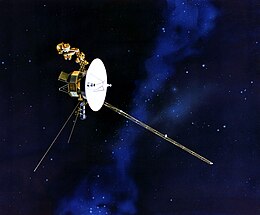Voyager 2

Voyager 2, artist's impression
|
|
| Mission type | Planetary exploration |
|---|---|
| Operator | NASA / JPL |
| COSPAR ID | 1977-076A |
| SATCAT № | 10271 |
| Website | voyager |
| Mission duration | 39 years, 5 months and 5 days elapsed Planetary mission: 12 years, 1 month, 12 days Interstellar mission: 27 years, 3 months and 23 days elapsed (continuing) |
| Spacecraft properties | |
| Manufacturer | Jet Propulsion Laboratory |
| Launch mass | 825.5 kilograms (1,820 lb) |
| Power | 420 watts |
| Start of mission | |
| Launch date | August 20, 1977, 14:29:00 UTC |
| Rocket | Titan IIIE |
| Launch site | Cape Canaveral LC-41 |
| Flyby of Jupiter | |
| Closest approach | July 9, 1979, 22:29:00 UTC |
| Distance | 570,000 kilometers (350,000 mi) |
| Flyby of Saturn | |
| Closest approach | August 25, 1981, 03:24:05 UTC |
| Distance | 101,000 km (63,000 mi) |
| Flyby of Uranus | |
| Closest approach | January 24, 1986, 17:59:47 UTC |
| Distance | 81,500 km (50,600 mi) |
| Flyby of Neptune | |
| Closest approach | August 25, 1989, 03:56:36 UTC |
| Distance | 4,951 km (3,076 mi) |
Voyager 2 is a space probe launched by NASA on August 20, 1977, to study the outer planets. Part of the Voyager program, it was launched 16 days before its twin, Voyager 1, on a trajectory that took longer to reach Jupiter and Saturn but enabled further encounters with Uranus and Neptune. It is the only spacecraft to have visited either of the ice giants.
Its primary mission ended with the exploration of the Neptunian system on October 2, 1989, after having visited the Uranian system in 1986, the Saturnian system in 1981, and the Jovian system in 1979. Voyager 2 is now in its extended mission to study the outer reaches of the Solar System and has been operating for 39 years, 5 months and 5 days. It remains in contact through the Deep Space Network.
At a distance of 112.5 AU (1.68×1010 km) from the Sun as of October 2016,Voyager 2 is one of the most distant human-made objects, along with Voyager 1, New Horizons, Pioneer 10 and Pioneer 11. The probe was moving at a velocity of 15.4 km/s (55,000 km/h) relative to the Sun as of December 2014 and is traveling through the heliosheath. Upon reaching interstellar space, Voyager 2 is expected to provide the first direct measurements of the density and temperature of the interstellar plasma.
...
Wikipedia
